JEE-Advanced-2021-Question-Paper-2
PHYSICS
SECTION-1
• This section contains SIX (06) questions.
• Each question has FOUR options (A), (B), (C) and (D). ONE OR MORE THAN ONE of these four option(s)
is (are) correct answer(s).
• For each question, choose the option(s) corresponding to (all) the correct answer(s).
• Answer to each question will be evaluated according to the following marking scheme:
Full Marks : +4 If only (all) the correct option(s) is(are) chosen;
Partial Marks : +3 If all the four options are correct but ONLY three options are chosen;
Partial Marks : +2 If three or more options are correct but ONLY two options are chosen, both of which are correct;
Partial Marks : +1 If two or more options are correct but ONLY one option is chosen and it is a correct option;
Zero Marks : 0 If unanswered;
Negative Marks : −2 In all other cases.
• For example, in a question, if (A), (B) and (D) are the ONLY three options corresponding to correct answers, then
choosing ONLY (A), (B) and (D) will get +4 marks;
choosing ONLY (A) and (B) will get +2 marks;
choosing ONLY (A) and (D) will get +2marks;
choosing ONLY (B) and (D) will get +2 marks;
choosing ONLY (A) will get +1 mark;
choosing ONLY (B) will get +1 mark;
choosing ONLY (D) will get +1 mark;
choosing no option(s) (i.e. the question is unanswered) will get 0 marks and
choosing any other option(s) will get −2 marks.
1. One end of a horizontal uniform beam of weight W and length L is hinged on a vertical wall at point O and its other end is supported by a light inextensible rope. The other end of the rope is fixed at point Q, at a height L above the hinge at point O. A block of weight αW is attached at point P of the beam, as shown in the figure (not to scale). The rope can sustain a maximum tension of (2√2) W Which of the following statement(s) is(are) correct?

(A) The vertical component of the reaction force at O does not depend on α
(B) The horizontal component of the reaction force at O is equal to W for α = 0.5
(C) The tension in the rope is 2W for α = 0.5
(D) The rope breaks if α > 1.5
2. A source, approaching with speed u towards the open end of a stationary pipe of length L, is emitting a sound of frequency fs. The farther end of the pipe is closed. The speed of sound in air is v and f0 is the fundamental frequency of the pipe. For which of the following combination(s) of u and fs, will the sound reaching the pipe lead to a resonance?
(A) u = 0.8v and fs = f0
(B) u = 0.8v and fs = 2f0
(C) u = 0.8v and fs = 0.5f0
(D) u = 0.5v and fs = 1.5f0
3. For a prism of prism angle θ = 60º, the refractive indices of the left half and the right half are, respectively, n1 and n2 (n2 ≥ n1) as shown in the figure. The angle of incidence is chosen such that the incident light rays will have minimum deviation if n1 = n2 = n = 1.5. For the case of unequal refractive indices, n1 = n and n2 = n + Δn (where Δn << n), the angle of emergence e = i + Δe. Which of the following statement(s) is(are) correct?

(A) The value of Δe (in radians) is greater than that of Δn
(B) Δe is proportional to Δn
(C) Δe lies between 2.0 and 3.0 milliradians if Δn = 2.8 × 10–3
(D) Δe lies between 1.0 and 1.6 milliradians if Δn = 2.8 × 10–3
4. A physical quantity ![]() where
where ![]() is electric field,
is electric field, ![]() is magnetic field and μ0 is the permeability of free space. The dimensions of
is magnetic field and μ0 is the permeability of free space. The dimensions of ![]() are the same as the dimensions of which of the following quantity (ies)?
are the same as the dimensions of which of the following quantity (ies)?
(A) 
(B) 
(C) ![]()
(D) ![]()
5. A heavy nucleus N, at rest, undergoes fission N → P + Q, where P and Q are two lighter nuclei. Let δ = MN – MP – MQ, where MP, MQ and MN are the masses of P, Q and N, respectively. EP and EQ are the kinetic energies of P and Q, respectively. The speeds of P and Q are VP and VQ, respectively. If c is the speed of light, which of the following statement(s) is(are) correct?
(A) EP + EQ = c2δ
(B) 
(C) 
(D) The magnitude of momentum for P as well as Q is 
6. Two concentric circular loops, one of radius R and the other of radius 2R lie in the xy-plane with the origin as their common centre, as shown in the figure. The smaller loop carries current I1 in the anti-clockwise direction and the larger loop carries current I2 in the clockwise direction, with I2 > 2I1.![]() denotes the magnetic field at a point (x, y) in the xy-plane. Which of the following statement(s) is(are) correct?
denotes the magnetic field at a point (x, y) in the xy-plane. Which of the following statement(s) is(are) correct?
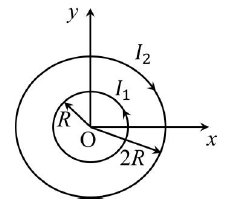
(A) ![]() is perpendicular to the xy-plane at any point in the plane
is perpendicular to the xy-plane at any point in the plane
(B) ![]() depends on x and y only through the radial distance
depends on x and y only through the radial distance 
(C) ![]() is non-zero at all points for r < R
is non-zero at all points for r < R
(D) ![]() points normally outward from the xy-plane for all the points between the two loops
points normally outward from the xy-plane for all the points between the two loops
SECTION-2
• This section contains THREE (03) question stems.
• There are TWO (02) questions corresponding to each question stem.
• The answer to each question is a NUMERICAL VALUE.
• For each question, enter the correct numerical value corresponding to the answer in the designated place using the mouse and the on-screen virtual numeric keypad.
• If the numerical value has more than two decimal places, truncate/round-off the value to TWO decimal places.
• Answer to each question will be evaluated according to the following marking scheme:
Full Marks : +2 If ONLY the correct numerical value is entered at the designated place;
Zero Marks : 0 In all other cases.
Question Stem for Question Nos. 7 and 8
A soft plastic bottle, filled with water of density 1 gm/cc, carries an inverted glass test tube with some air (ideal gas) trapped as shown in the figure. The test tube has a mass of 5 gm, and it is made of a thick glass of density 2.5 gm/cc. Initially, the bottle is sealed at atmospheric pressure p0 = 105 Pa so that the volume of the trapped air is V0 = 3.3 cc. When the bottle is squeezed from outside at a constant temperature, the pressure inside rises and the volume of the trapped air reduces. It is found that the test tube begins to sink at pressure p0 + Δp without changing its orientation. At this pressure, the volume of the trapped air is V0 – ΔV.
Let ΔV = X cc and Δp = Y × 103 Pa.
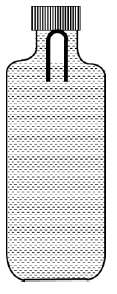
7. The value of X is ______.
8. The value of Y is _____.
Question Stem for Question Nos. 9 and 10
A pendulum consists of a bob of mass m = 0.1 kg and a massless inextensible string of length L = 1.0 m. It is suspended from a fixed point at height H = 0.9 m above a frictionless horizontal floor. Initially, the bob of the pendulum is lying on the floor at rest vertically below the point of suspension. A horizontal impulse P = 0.2 kg-m/s is imparted to the bob at some instant. After the bob slides for some distance, the string becomes taut and the bob lifts off the floor. The magnitude of the angular momentum of the pendulum about the point of suspension just before the bob lifts off is J kg-m2/s. The kinetic energy of the pendulum just after the lift-off is K Joules.
9. The value of J is ________.
10. The value of K is __________.
Question Stem for Question Nos. 11 and 12
In a circuit, a metal filament lamp is connected in series with a capacitor of capacitance C μF across a 200 V, 50 Hz supply. The power consumed by the lamp is 500 W while the voltage drop across it is 100 V. Assume that there is no inductive load in the circuit. Take rms values of the voltages. The magnitude of the phase angle (in degrees) between the current and the supply voltage is ϕ. Assume, π√3 = 5.
11. The value of C is ___.
12. The value of ϕ is ___.
SECTION-3
• This section contains TWO (02) paragraphs. Based on each paragraph, there are TWO (02) questions.
• Each question has FOUR options (A), (B), (C) and (D). ONLY ONE of these four options is the correct answer.
• For each question, choose the option corresponding to the correct answer.
• Answer to each question will be evaluated according to the following marking scheme:
Full Marks : +3 If ONLY the correct option is chosen;
Zero Marks : 0 If none of the options is chosen (i.e. the question is unanswered);
Negative Marks : −1 In all other cases.
Paragraph Question 13 and 14
A special metal S conducts electricity without any resistance. A closed wire loop, made of S, does not allow any change in flux through itself by inducing a suitable current to generate a compensating flux. The induced current in the loop cannot decay due to its zero resistance. This current gives rise to a magnetic moment which in turn repels the source of magnetic field or flux. Consider such a loop, of radius a, with its centre at the origin. A magnetic dipole of moment m is brought along the axis of this loop from infinity to a point at distance r (>> a) from the centre of the loop with its north pole always facing the loop, as shown in the figure below.
The magnitude of the magnetic field of a dipole m, at a point on its axis at distance r, is ![]() where μ0 is the permeability of free space. The magnitude of the force between two magnetic dipoles with moments, m1 and m2, separated by a distance r on the common axis, with their north poles facing each other, is
where μ0 is the permeability of free space. The magnitude of the force between two magnetic dipoles with moments, m1 and m2, separated by a distance r on the common axis, with their north poles facing each other, is ![]() where k is a constant of appropriate dimensions. The direction of this force is along the line joining the two dipoles.
where k is a constant of appropriate dimensions. The direction of this force is along the line joining the two dipoles.

13. When the dipole m is placed at a distance r from the centre of the loop (as shown in the figure), the current induced in the loop will be proportional to?
(A) m/r3
(B) m2/r2
(C) m/r2
(D) m2/r
14. The work done in bringing the dipole from infinity to a distance r from the centre of the loop by the given process is proportional to?
(A) m/r5
(B) m2/r5
(C) m2/r6
(D) m2/r7
Paragraph Question 15 and 16
A thermally insulating cylinder has a thermally insulating and frictionless movable partition in the middle, as shown in the figure below. On each side of the partition, there is one mole of an ideal gas, with specific heat at constant volume, CV = 2R. Here, R is the gas constant. Initially, each side has a volume V0 and temperature T0. The left side has an electric heater, which is turned on at very low power to transfer heat Q to the gas on the left side. As a result, the partition moves slowly towards the right, reducing the right side volume to V0/2. Consequently, the gas temperatures on the left and the right sides become TL and TR, respectively. Ignore the changes in the temperatures of the cylinder, heater and partition.

15. The value of TR/T0 is
(A) √2
(B) √3
(C) 2
(D) 3
16. The value of Q/RT0 is
(A) 4(2√2 +1)
(B) 4(2√2 −1)
(C) (5√2 +1)
(D) (5√2 −1)
SECTION-4
• This section contains THREE (03) questions.
• The answer to each question is a NON-NEGATIVE INTEGER.
• For each question, enter the correct integer corresponding to the answer using the mouse and the on-screen virtual numeric keypad in the place designated to enter the answer.
• Answer to each question will be evaluated according to the following marking scheme:
Full Marks : +4 If ONLY the correct integer is entered;
Zero Marks : 0 In all other cases.
17. In order to measure the internal resistance r1 of a cell of emf E, a meter bridge of wire resistance R0 = 50 Ω, a resistance R0/2, another cell of emf E/2 (internal resistance r) and a galvanometer G are used in a circuit, as shown in the figure. If the null point is found at l = 72 cm, then the value of r 1 = ___ Ω.
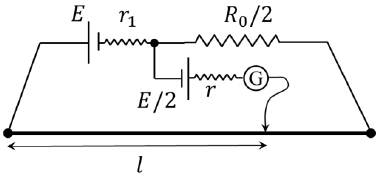
18. The distance between two stars of masses 3MS and 6MS is 9R. Here R is the mean distance between the centres of the Earth and the Sun, and MS is the mass of the Sun. The two stars orbit around their common centre of mass in circular orbits with period nT, where T is the period of Earth’s revolution around the Sun. The value of n is ___.
19. In a photoemission experiment, the maximum kinetic energies of photoelectrons from metals P, Q and R are EP, EQ and ER, respectively, and they are related by EP = 2EQ = 2ER. In this experiment, the same source of monochromatic light is used for metals P and Q while a different source of monochromatic light is used for metal R. The work functions for metals P, Q and R are 4.0 eV, 4.5 eV and 5.5 eV, respectively. The energy of the incident photon used for metal R, in eV, is _____.
CHEMISTRY
SECTION-1
• This section contains SIX (06) questions.
• Each question has FOUR options (A), (B), (C) and (D). ONE OR MORE THAN ONE of these four option(s)
is (are) correct answer(s).
• For each question, choose the option(s) corresponding to (all) the correct answer(s).
• Answer to each question will be evaluated according to the following marking scheme:
Full Marks : +4 If only (all) the correct option(s) is(are) chosen;
Partial Marks : +3 If all the four options are correct but ONLY three options are chosen;
Partial Marks : +2 If three or more options are correct but ONLY two options are chosen, both of which are correct;
Partial Marks : +1 If two or more options are correct but ONLY one option is chosen and it is a correct option;
Zero Marks : 0 If unanswered;
Negative Marks : −2 In all other cases.
• For example, in a question, if (A), (B) and (D) are the ONLY three options corresponding to correct answers, then
choosing ONLY (A), (B) and (D) will get +4 marks;
choosing ONLY (A) and (B) will get +2 marks;
choosing ONLY (A) and (D) will get +2marks;
choosing ONLY (B) and (D) will get +2 marks;
choosing ONLY (A) will get +1 mark;
choosing ONLY (B) will get +1 mark;
choosing ONLY (D) will get +1 mark;
choosing no option(s) (i.e. the question is unanswered) will get 0 marks and
choosing any other option(s) will get −2 marks.
1. The reaction sequence(s) that would lead to o-xylene as the major product is(are).

2. Correct option(s) for the following sequence of reactions is(are)

(A) Q = KNO2, W = LiAlH4
(B) R = benzenamine, V = KCN
(C) Q = AgNO2, R = phenylmethanamine
(D) W = LiAlH4, V = AgCN
3. For the following reaction;

the rate of reaction is ![]() Two moles of X are mixed with one mole of Y to make 1.0 L of solution. At 50 s, 0.5 mole of Y is left in the reaction mixture. The correct statement(s) about the reaction is(are).
Two moles of X are mixed with one mole of Y to make 1.0 L of solution. At 50 s, 0.5 mole of Y is left in the reaction mixture. The correct statement(s) about the reaction is(are).
(Use: ln 2 = 0.693)
(A) The rate constant, k, of the reaction is 13.86 × 10-4 s-1.
(B) Half-life of X is 50 s.
(C) At 50 s, ![]()
(D) At 100 s, ![]()
4. Some standard electrode potentials at 298 K are given below:
Pb2+/Pb –0.13 V
Ni2+/Ni –0.24 V
C2+/Cd –0.40 V
Fe2+/Fe –0.44 V
To a solution containing 0.001 M of X2+ and 0.1 M of Y2+, the metal rods X and Y are inserted (at 298 K) and connected by a conducting wire. This resulted in the dissolution of X.
The correct combination(s) of X and Y, respectively, is(are)
(Given: Gas constant, R = 8.314 J K−1 mol−1, Faraday constant, F = 96500 C mol−1)
(A) Cd and Ni
(B) Cd and Fe
(C) Ni and Pb
(D) Ni and Fe
5. The pair(s) of complexes wherein both exhibit tetrahedral geometry is(are) (Note: py = pyridine, Given: Atomic numbers of Fe, Co, Ni and Cu are 26, 27, 28 and 29, respectively)
(A) [FeCl4]– and [Fe(CO)4]2–
(B) [Co(CO)4]– and [CoCl4]2–
(C) [Ni(CO)4] and [Ni(CN)4]2–
(D) [Cu(py)4]+ and [Cu(CN)4]3–
6. The correct statement(s) related to oxoacids of phosphorous is(are).
(A) Upon heating, H3PO3 undergoes a disproportionation reaction to produce H3PO4 and PH3.
(B) While H3PO3 can act as a reducing agent, H3PO4 cannot.
(C) H3PO3 is a monobasic acid.
(D) The H atom of the P-H bond in H3PO3 is not ionizable in water.
SECTION-2
• This section contains THREE (03) question stems.
• There are TWO (02) questions corresponding to each question stem.
• The answer to each question is a NUMERICAL VALUE.
• For each question, enter the correct numerical value corresponding to the answer in the designated place using the mouse and the on-screen virtual numeric keypad.
• If the numerical value has more than two decimal places, truncate/round-off the value to TWO decimal places.
• Answer to each question will be evaluated according to the following marking scheme:
Full Marks : +2 If ONLY the correct numerical value is entered at the designated place;
Zero Marks : 0 In all other cases.
Question Stem for Question Nos. 7 and 8
Question Stem
At 298 K, the limiting molar conductivity of a weak monobasic acid is 4 × 102 S cm2 mol–1. At 298 K, for an aqueous solution of the acid, the degree of dissociation is a and the molar conductivity is y × 102 S cm2 mol–1. At 298 K, upon 20 times dilution with water, the molar conductivity of the solution becomes 3y × 102 S cm2 mol–1.
7. The value of α is _______.
8. The value of y is _______.
Question Stem for Question Nos. 9 and 10
Question Stem
The reaction of x g of Sn with HCl quantitatively produced a salt. The entire amount of the salt reacted with y g of nitrobenzene in the presence of the required amount of HCl to produce 1.29 g of an organic salt (quantitatively).
(Use Molar masses (in g mol–1) of H, C, N, O, Cl and Sn as 1, 12, 14, 16, 35 and 119, respectively).
9. The value of x is ________.
10. The value of y is ________.
Question Stem for Question Nos. 11 and 12
Question Stem
A sample (5.6 g) containing iron is completely dissolved in cold dilute HCl to prepare a 250 mL of solution. Titration of 25.0 mL of this solution requires 12.5 mL of 0.03 M KMnO4 solution to reach the endpoint. Number of moles of Fe2+ present in 250 mL solution is x × 10–2 (consider complete dissolution of FeCl2). The amount of iron present in the sample is y% by weight.
(Assume: KMnO4 reacts only with Fe2+ in the solution Use: Molar mass of iron as 56 g mol–1)
11. The value of x is ________.
12. The value of y is ________.
SECTION-3
• This section contains TWO (02) paragraphs. Based on each paragraph, there are TWO (02) questions.
• Each question has FOUR options (A), (B), (C) and (D). ONLY ONE of these four options is the correct answer.
• For each question, choose the option corresponding to the correct answer.
• Answer to each question will be evaluated according to the following marking scheme:
Full Marks : +3 If ONLY the correct option is chosen;
Zero Marks : 0 If none of the options is chosen (i.e. the question is unanswered);
Negative Marks : −1 In all other cases.
Paragraph Question 13 and 14
Statement: The amount of energy required to break a bond is the same as the amount of energy released when the same bond is formed. In a gaseous state, the energy required for homolytic cleavage of a bond is called Bond Dissociation Energy (BDE) or Bond Strength. BDE is affected by the s-character of the bond and the stability of the radicals formed. Shorter bonds are typically stronger bonds. BDEs for some bonds are given below:
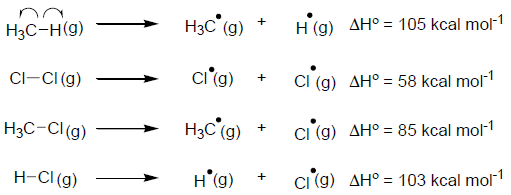
13. The correct match of the C-H bonds (shown in bold) in Column J with their BDE in Column K is;
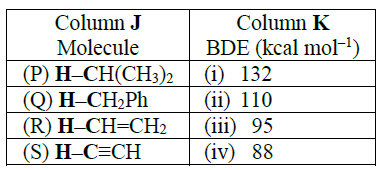
(A) P – iii, Q – iv, R – ii, S – i
(B) P – i, Q – ii, R – iii, S – iv
(C) P – iii, Q – ii, R – i, S – iv
(D) P – ii, Q – i, R – iv, S – iii
14. For the following reaction,

the correct statement is
(A) Initiation step is exothermic with DH° = –58 kcal mol–1
(B) Propagation step involving ·CH3 formation is exothermic with DH° = –2 kcal mol–1
(C) Propagation step involving CH3Cl formation is endothermic with DH° = +27 kcal mol–1
(D) The reaction is exothermic with DH° = –25 kcal mol–1
Paragraph Question 15 and 16
The reaction of K3[Fe(CN)6] with freshly prepared FeSO4 solution produces a dark blue precipitate called Turnbull’s blue. The reaction of K4[Fe(CN)6] with the FeSO4 solution in the complete absence of air produces a white precipitate X, which turns blue in the air. Mixing the FeSO4 solution with NaNO3, followed by slow addition of concentrated H2SO4 through the side of the test tube produces a brown ring.
15. Precipitate X is
(A) Fe4[Fe(CN)6]3
(B) Fe4[Fe(CN)6]
(C) K2Fe[Fe(CN)6]
(D) KFe[Fe(CN)6]
16. Among the following, the brown ring is due to the formation of
(A) [Fe(NO)2(SO4)2]2–
(B) [Fe(NO)2(H2O)4]3+
(C) [Fe(NO)4(SO4)2]
(D) [Fe(NO)(H2O)5]2+
SECTION-4
• This section contains THREE (03) questions.
• The answer to each question is a NON-NEGATIVE INTEGER.
• For each question, enter the correct integer corresponding to the answer using the mouse and the on-screen virtual numeric keypad in the place designated to enter the answer.
• Answer to each question will be evaluated according to the following marking scheme:
Full Marks : +4 If ONLY the correct integer is entered;
Zero Marks : 0 In all other cases.
17. One mole of an ideal gas at 900 K, undergoes two reversible processes, I followed by II, as shown below. If the work done by the gas in the two processes are the same, the value of V3/V2 is _________.
(U: internal energy, S: entropy, p: pressure, V: volume, R: gas constant)
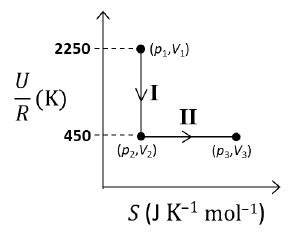
(Given: molar heat capacity at constant volume, C of the gas is ![]() )
)
18. Consider a helium (He) atom that absorbs a photon of wavelength 330 nm. The change in the velocity (in cm s−1) of the He atom after the photon absorption is_____.
(Assume: Momentum is conserved when the photon is absorbed.
Use: Planck constant = 6.6 × 10−34 J s, Avogadro number = 6 × 1023 mol−1, Molar mass of He = 4 g mol−1)
19. Ozonolysis of ClO2 produces oxide of chlorine. The average oxidation state of chlorine in this oxide is ____.
MATHEMATICS
SECTION-1
• This section contains SIX (06) questions.
• Each question has FOUR options (A), (B), (C) and (D). ONE OR MORE THAN ONE of these four option(s)
is (are) correct answer(s).
• For each question, choose the option(s) corresponding to (all) the correct answer(s).
• Answer to each question will be evaluated according to the following marking scheme:
Full Marks : +4 If only (all) the correct option(s) is(are) chosen;
Partial Marks : +3 If all the four options are correct but ONLY three options are chosen;
Partial Marks : +2 If three or more options are correct but ONLY two options are chosen, both of which are correct;
Partial Marks : +1 If two or more options are correct but ONLY one option is chosen and it is a correct option;
Zero Marks : 0 If unanswered;
Negative Marks : −2 In all other cases.
• For example, in a question, if (A), (B) and (D) are the ONLY three options corresponding to correct answers, then
choosing ONLY (A), (B) and (D) will get +4 marks;
choosing ONLY (A) and (B) will get +2 marks;
choosing ONLY (A) and (D) will get +2marks;
choosing ONLY (B) and (D) will get +2 marks;
choosing ONLY (A) will get +1 mark;
choosing ONLY (B) will get +1 mark;
choosing ONLY (D) will get +1 mark;
choosing no option(s) (i.e. the question is unanswered) will get 0 marks and
choosing any other option(s) will get −2 marks.
1. Let;
S1 = {(i, j, k) : i, j, k ∈ {1,2,…,10}}
S2 = {(i, j) : 1 ≤ i < j + 2 ≤ 10,i, j ∈ {1, 2, …, 10}}
S3 = {(i, j, k, l) : 1 ≤ i < j < k < l, i, j, k, l ∈ {1, 2, …, 10}}
S4 = {(i, j, k, l ) : i, j, k and l are distinct elements in {1, 2, …, 10}}.
If the total number of elements in the set Sr is nr, r = 1, 2, 3, 4, then which of the following statements is (are) TRUE?
(A) n1 = 1000
(B) n2 = 44
(C) n3 = 220
(D) ![]()
2. Consider a triangle PQR having sides of lengths p, q, and r opposite to the angles P, Q, and R, respectively. Then which of the following statements is (are) TRUE?
(A) 
(B) 
(C) 
(D) If p < q and p < r, then cos Q > p/r and cos R > p/q
3. Let  be a continuous function such that
be a continuous function such that 
Then which of the following statements is (are) TRUE?
(A) The equation f(x) − 3 cos 3x = 0 has at least one solution in (0, π/3)
(B) The equation f(x) − 3 sin 3x = −6/π has at least one solution in (0, π/3)
(C) 
(D) 
4. For any real numbers α and β, let yα, β (x), x ∈ R, be the solution of the differential equation  Let S = {yα,β (x), α, β ∈ R } . Then which of the following functions belong(s) to the set S?
Let S = {yα,β (x), α, β ∈ R } . Then which of the following functions belong(s) to the set S?
(A) 
(B) 
(C) 
(D) 
5. Let O be the origin ![]()
![]() and
and ![]() for some λ > 0. If
for some λ > 0. If ![]() then which of the following statement is (are) TRUE?
then which of the following statement is (are) TRUE?
(A) Projection of ![]()
(B) Area of the triangle OAB is 9/2
(C) Area of the triangle ABC is 9/2
(D) The acute angle between the diagonals of the parallelogram with adjacent sides ![]()
6. Let E denote the parabola y2 = 8x. Let P = (−2, 4), and let Q and Q’ be two distinct points on E such that the lines PQ and PQ’ are tangents to E. Let F be the focus of E. Then which of the following statements is (are) TRUE?
(A) The triangle PFQ is a right-angled triangle
(B) The triangle QPQ’ is a right-angled triangle
(C) The distance between P and F is 5√2
(D) F lies on the line joining Q and Q’
SECTION-2
• This section contains THREE (03) question stems.
• There are TWO (02) questions corresponding to each question stem.
• The answer to each question is a NUMERICAL VALUE.
• For each question, enter the correct numerical value corresponding to the answer in the designated place using the mouse and the on-screen virtual numeric keypad.
• If the numerical value has more than two decimal places, truncate/round-off the value to TWO decimal places.
• Answer to each question will be evaluated according to the following marking scheme:
Full Marks : +2 If ONLY the correct numerical value is entered at the designated place;
Zero Marks : 0 In all other cases.
Question Stem for Question Nos. 7 and 8
Question Stem
Consider the region R = {(x,y) ∈ R×R : x ≥ 0 and y2 ≤ 4 – x. Let F be the family of all circles that are contained in R and have centres on the x-axis. Let C be the circle that has the largest radius among the circles in F. Let (α, β) be a point where circle C meets the curve y2 = 4 − x.
7. The radius of the circle C is ______.
8. The value of α is ________.
Question Stem for Question Nos. 9 and 10
Question Stem
Let f1 : (0, ∞) → R and f2 : (0, ∞) → R be defined by

and
f2(x) = 98(x – 1)50 – 600(x – 1)49 +2450, x> 0,
where, for any positive integer n and real numbers a1, a2, … an, ![]() denotes the product of a1, a2, … an. Let mi and ni, respectively, denote the number of points of local minima and the number of points of local maxima of function fi, i = 1, 2, in the interval (0, ∞).
denotes the product of a1, a2, … an. Let mi and ni, respectively, denote the number of points of local minima and the number of points of local maxima of function fi, i = 1, 2, in the interval (0, ∞).
9. The value 2m1 + 3n1 + m1n1 is ______.
10. The value of 6m2 + 4n2 + 8m2n2 is_____.
Question Stem for Question Nos. 11 and 12
Question Stem
Let  i = 1, 2, and
i = 1, 2, and  be functions such that g1(x) = 1, g2(x) = |4x – π| and f(x) = sin2 x, for all
be functions such that g1(x) = 1, g2(x) = |4x – π| and f(x) = sin2 x, for all 
Define

11. The value of ![]() is ______.
is ______.
12. The value of ![]() is _______.
is _______.
SECTION-3
• This section contains TWO (02) paragraphs. Based on each paragraph, there are TWO (02) questions.
• Each question has FOUR options (A), (B), (C) and (D). ONLY ONE of these four options is the correct answer.
• For each question, choose the option corresponding to the correct answer.
• Answer to each question will be evaluated according to the following marking scheme:
Full Marks : +3 If ONLY the correct option is chosen;
Zero Marks : 0 If none of the options is chosen (i.e. the question is unanswered);
Negative Marks : −1 In all other cases.
Paragraph Question 13 and 14
Let M = {(x, y) ∈ R × R : x2 + y2 ≤ r2}, where r > 0. Consider the geometric progression ![]() Let S0 = 0 and, for n ≥ 1, let Sn denote the sum of the first n terms of this progression. For n ≥ 1 , let Cn denote the circle with center (Sn–1, 0) and radius an, and Dn denote the circle with center (Sn–1, Sn–1) and radius an.
Let S0 = 0 and, for n ≥ 1, let Sn denote the sum of the first n terms of this progression. For n ≥ 1 , let Cn denote the circle with center (Sn–1, 0) and radius an, and Dn denote the circle with center (Sn–1, Sn–1) and radius an.
13. Consider M with ![]() Let k be the number of all those circles Cn that are inside M. Let l be the maximum possible number of circles among these k circles such that no two circles intersect. Then,
Let k be the number of all those circles Cn that are inside M. Let l be the maximum possible number of circles among these k circles such that no two circles intersect. Then,
(A) k + 2l = 22
(B) 2k + l = 26
(C) 2k + 3l = 34
(D) 3k + 2l = 40
14. Consider M with  The number of all those circles Dn that are inside M is;
The number of all those circles Dn that are inside M is;
(A) 198
(B) 199
(C) 200
(D) 201
Paragraph Question 15 and 16
Let ψ1 = [0, ∞) → R, ψ2 = [0, ∞) → R, f:[0, ∞) → R and g:[0, ∞) → R be functions such that f(0) = g(0) = 0,
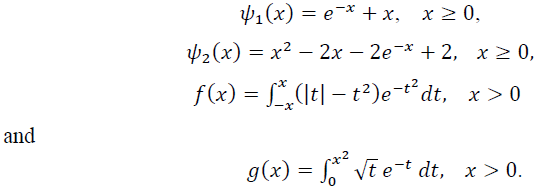
15. Which of the following statements is TRUE?
(A) ![]()
(B) For every x > 1, there exists an α ∈ (1, x) such that ψ1(x) = 1 + α x
(C) For every x > 0, there exists a β ∈ (0, x) such that ψ2(x) = 2x (ψ1(β) −1)
(D) f is an increasing function on the interval [0, 3/2]
16. Which of the following statements is TRUE?
(A) ψ1(x) ≤ 1, for all x > 0
(B) ψ2(x) ≤ 0, for all x > 0
(C) 
(D) 
SECTION-4
• This section contains THREE (03) questions.
• The answer to each question is a NON-NEGATIVE INTEGER.
• For each question, enter the correct integer corresponding to the answer using the mouse and the on-screen virtual numeric keypad in the place designated to enter the answer.
• Answer to each question will be evaluated according to the following marking scheme:
Full Marks : +4 If ONLY the correct integer is entered;
Zero Marks : 0 In all other cases.
17. A number is chosen at random from the set {1, 2, 3……, 2000}. Let p be the probability that the number is a multiple of 3 or a multiple of 7. Then the value of 500p is;
18. Let E be the ellipse  For any three distinct points P, Q and Q’ on E, let M (P, Q) be the mid-point of the line segment joining P and Q, and M(P, Q’) be the mid-point of the line segment joining P and Q’. Then the maximum possible value of the distance between M (P, Q) and M(P, Q’), as P, Q and Q’ vary on E, is
For any three distinct points P, Q and Q’ on E, let M (P, Q) be the mid-point of the line segment joining P and Q, and M(P, Q’) be the mid-point of the line segment joining P and Q’. Then the maximum possible value of the distance between M (P, Q) and M(P, Q’), as P, Q and Q’ vary on E, is
19. For any real number x, let [x] denote the largest integer less than or equal to x. If  then the value of 9I is ______.
then the value of 9I is ______.
Latest Govt Job & Exam Updates: